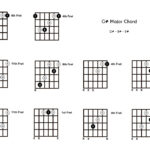As a devoted fan of rhythm action games, I remained hooked on every new Guitar Hero and Rock Band release, even as the genre’s mainstream popularity waned. Therefore, the resurgence of both series in 2015 was a momentous event for enthusiasts like myself. The fact that Guitar Hero Live and Rock Band 4 presented distinct approaches made the competition even more captivating.
However, for many gamers, choosing between two rhythm game titans can be a tough decision. If you’re looking to dive back into the world of plastic instruments but are unsure which game to pick, this comprehensive comparison is for you. Having personally invested in both Guitar Hero Live and Rock Band 4 upon their release and dedicated considerable time to each, I’m well-positioned to offer an objective and detailed analysis to guide your choice. Let’s get ready to rock and explore which game truly hits the high notes for your rhythm gaming desires.
Round 1: Backwards Compatibility and Instrument Libraries
For seasoned rhythm game players, the question of instrument compatibility is crucial. Many homes harbor collections of plastic guitars and drum sets from previous Guitar Hero and Rock Band eras. A game that allows you to dust off and reuse these peripherals offers significant value.
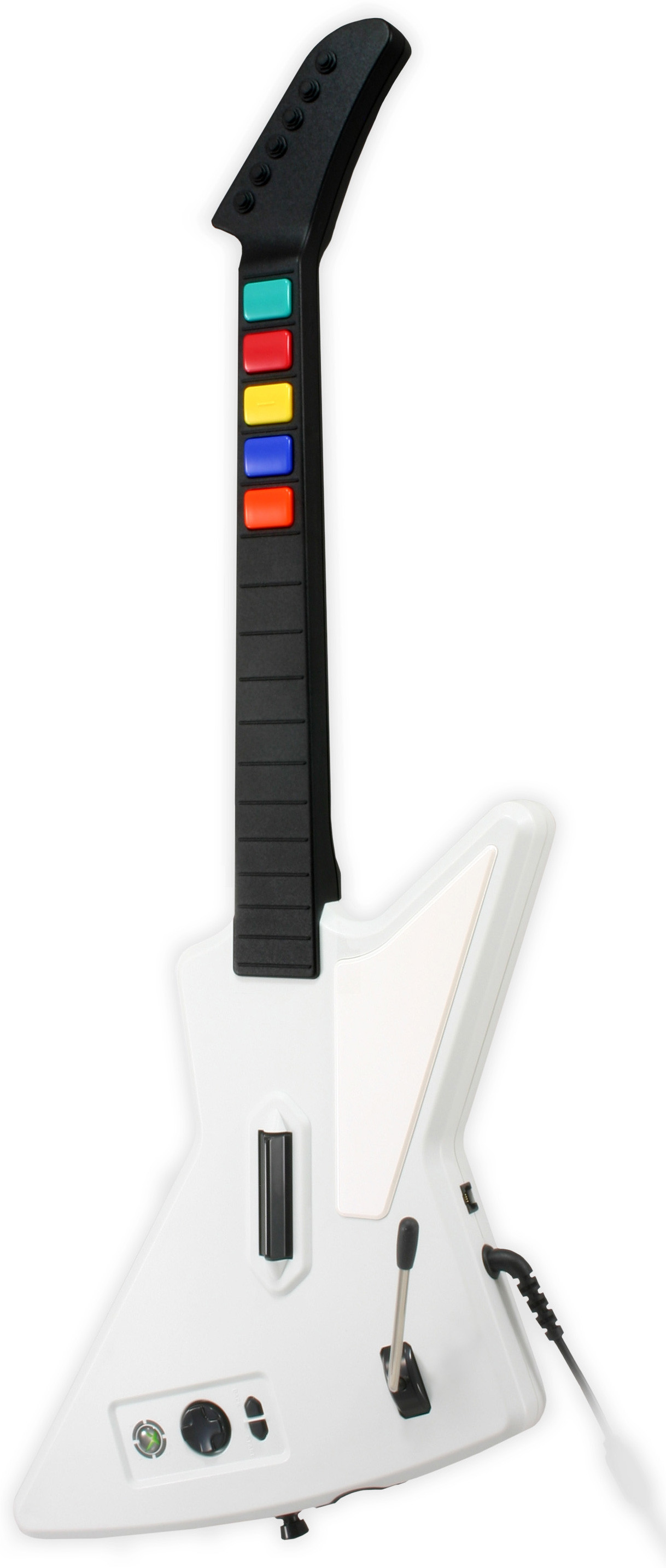 Sleep well, sweet prince of plastic video game instruments
Sleep well, sweet prince of plastic video game instruments
A classic Guitar Hero 2 controller, representing the legacy of plastic instruments in gaming.
Rock Band 4 proudly champions backwards compatibility, largely succeeding in its promise to support older Rock Band and Guitar Hero instruments. My wireless Guitar Hero 3 Xbox 360 guitar seamlessly connected and worked flawlessly with the Xbox One version of Rock Band 4. This commitment to legacy hardware is a significant advantage for players invested in the Rock Band ecosystem.
However, complete compatibility isn’t without minor caveats. Due to Microsoft’s device authentication protocols, wired controllers are not supported. This meant retiring my beloved Guitar Hero II Xplorer, a personal favorite used across countless hours of Xbox 360 Guitar Hero and Rock Band. While a niche issue, it’s worth noting for purists with specific wired setups. Nevertheless, most wireless last-generation controllers are expected to function smoothly with Rock Band 4.
In stark contrast, Guitar Hero Live adopts a completely different stance on instrument compatibility. The game introduces a redesigned guitar controller with a novel button layout (detailed in the next section). This fundamental shift in control scheme renders older five-button controllers incompatible. Consequently, your existing Guitar Hero and Rock Band instrument collection cannot be used with Guitar Hero Live. This necessitates purchasing new hardware to experience Guitar Hero Live play, which may be a barrier for players already equipped with rhythm game peripherals.
Winner: Rock Band 4
Round 2: Guitar Gameplay and Controller Innovation
While Rock Band broadened the rhythm game experience to include drums, vocals, and keyboards, the guitar remains the iconic instrument for many fans. The core guitar gameplay experience is a critical differentiator between Guitar Hero Live and Rock Band 4.
Rock Band 4 adheres to the established five-color lane system, a familiar and comfortable layout for veterans of the genre. If you’ve played previous Rock Band or Guitar Hero titles, you’ll instantly feel at home with Rock Band 4‘s guitar gameplay. The fundamental mechanics remain largely unchanged, providing a smooth transition for returning players.
The primary gameplay innovation in Rock Band 4 comes in the form of Freestyle Guitar Solos. These sections empower players to improvise solos, generating musical phrases that the game dynamically interprets to create coherent-sounding guitar parts.
 Rock Band 4
Rock Band 4
Rock Band 4’s familiar note highway, offering a classic rhythm game experience.
These freestyle solos, while conceptually interesting and reminiscent of Harmonix’s Fantasia game, can sometimes sound disjointed. Thankfully, the option to disable them exists for players who prefer a more traditional solo experience. Rock Band 4 prioritizes evolution, refining the established formula while maintaining the core gameplay that fans know and love.
Guitar Hero Live, however, embraces revolution in its guitar gameplay. It abandons the five-color button system entirely, introducing a brand-new guitar controller featuring two rows of three buttons on the guitar neck. This innovative design fundamentally alters the Guitar Hero Live play experience.
The new six-button layout aims to emulate the feel of playing a real guitar. On higher difficulty settings, players encounter complex chord shapes spanning both rows of buttons, demanding precise finger positioning and coordination. Mastering these intricate patterns provides a rewarding sense of accomplishment as muscle memory develops, enabling seamless execution of challenging musical passages.
Freestyle Games, the developer behind Guitar Hero Live and the acclaimed DJ Hero, has a proven track record of creating innovative peripherals. The Guitar Hero Live guitar represents a bold gamble that, after an initial adjustment period, genuinely enhances the guitar playing experience. The new control scheme offers a more engaging and nuanced feel, arguably surpassing the widely accepted five-button standard in terms of emulating actual guitar playing sensations.
Winner: Guitar Hero Live
Round 3: Instrument Variety and Band Experience
The scope of instrument options and the overall band experience diverge significantly between Guitar Hero Live and Rock Band 4. This distinction directly impacts the type of multiplayer and musical experiences each game offers.
Rock Band 4 stays true to its band-centric roots, emphasizing collaborative gameplay with a full ensemble. Drums, bass guitar, and vocals remain integral components of the Rock Band 4 play experience. As with guitars, most wireless legacy controllers for these instruments are compatible, further enhancing the accessibility for returning players.
Regrettably, Rock Band 4 omits keyboard support, a feature previously explored in Rock Band 3. This decision sidelines a potentially enriching instrument and limits the instrumental diversity within the Rock Band 4 ecosystem.
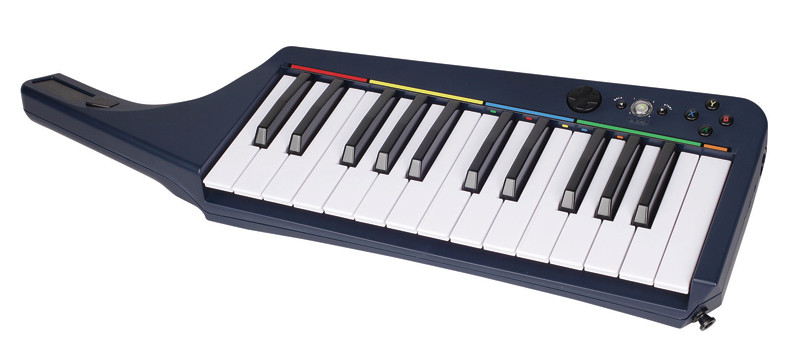 I suppose you can sleep well too, though I
I suppose you can sleep well too, though I
A Rock Band 3 keyboard controller, a reminder of the series’ broader instrumental ambitions, not fully realized in Rock Band 4.
Guitar Hero Live, conversely, focuses intensely on the lead guitar experience, streamlining the gameplay to a singular instrument. Drumming and bass guitar are entirely absent from Guitar Hero Live play. The game prioritizes mastering the guitar, offering a focused and refined experience for guitar enthusiasts.
While Guitar Hero Live primarily centers on guitar, it does include vocal support via a compatible Logitech microphone or a Guitar Hero Live companion app for iOS devices. However, vocals are a secondary element, reinforcing the game’s core identity as a guitar-centric experience. For players seeking a full band experience, Guitar Hero Live falls short compared to Rock Band 4.
Winner: Rock Band 4
Round 4: Visual Presentation and Immersion
Visual design significantly contributes to the overall feel and immersion of a rhythm game. Rock Band 4 and Guitar Hero Live adopt radically different visual styles, each with its own strengths and weaknesses.
Rock Band 4 maintains a visual aesthetic consistent with previous entries in the series. While offering enhanced graphical fidelity, the core visual style remains largely unchanged. Players still create stylized, polygonal characters and form bands, a familiar visual framework for Rock Band veterans.
 Let
Let
Rock Band 4’s character creator and stylized visual approach, familiar to series fans.
This established engine is designed to accommodate a vast library of downloadable content, ensuring seamless integration of DLC songs with character animations and lip-syncing. Rock Band 4‘s visual presentation prioritizes consistency and scalability for its extensive music library.
Guitar Hero Live takes a dramatically different visual approach, emphasizing full-motion video. This visual direction manifests in two distinct gameplay modes: GHTV and GH Live.
GHTV functions as a streaming music television channel, presenting songs alongside their official music videos. This format offers a dynamic and visually engaging way to discover new music, aligning with the genre’s inherent appeal of musical exploration.
GH Live mode immerses players in first-person concert performances, with dynamic crowd reactions based on player performance.
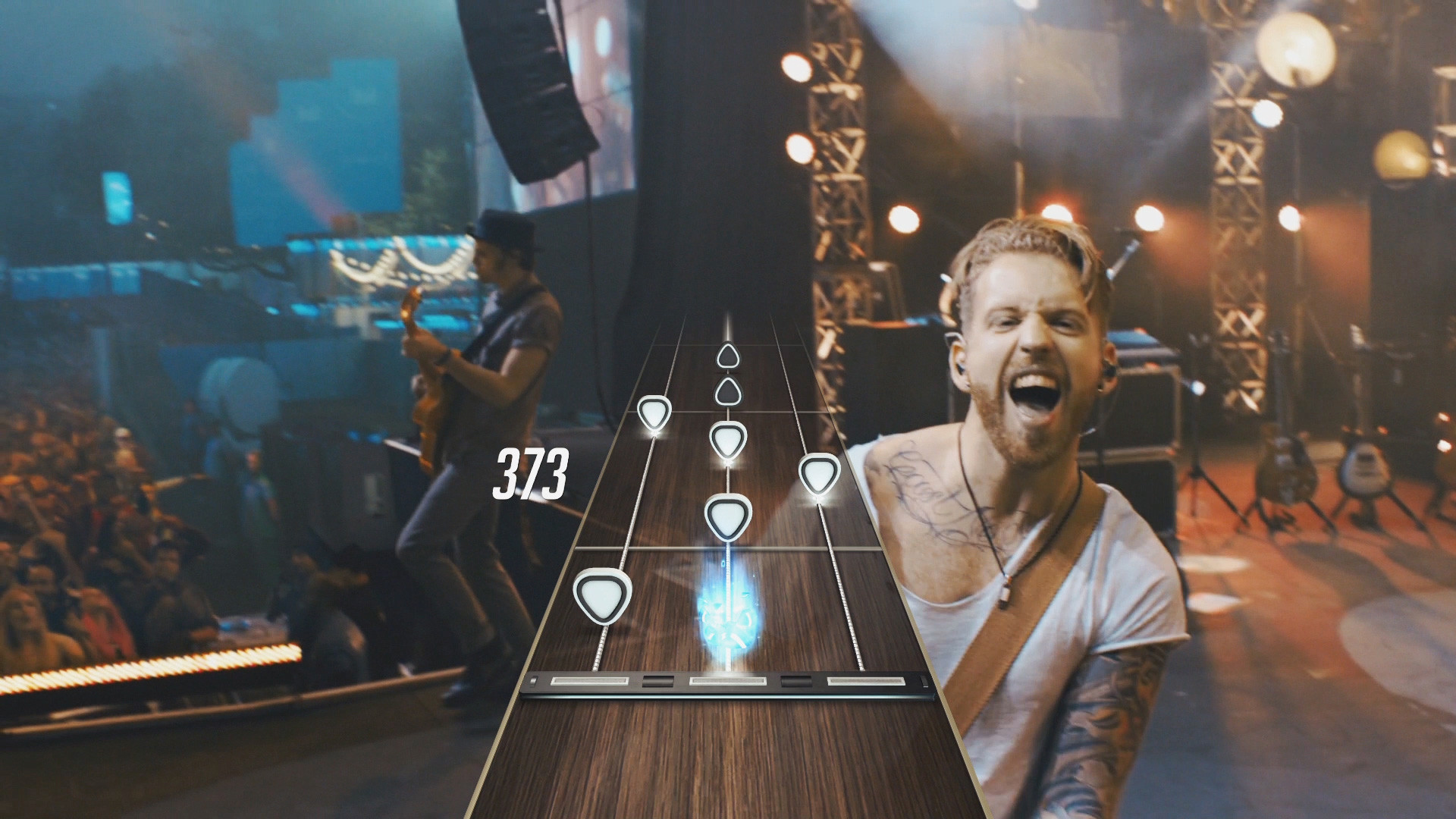 Get off my fucking telly, you complete and utter immaculate moron
Get off my fucking telly, you complete and utter immaculate moron
Guitar Hero Live’s first-person perspective and live-action visuals, aiming for concert immersion.
While technically well-executed, the GH Live mode’s live-action visuals can be polarizing. Some may find the performances and crowd reactions to be somewhat artificial or even cringeworthy, detracting from the immersion. The stylized perfection of the on-screen band and audience may feel unrealistic to some players, creating a disconnect from the intended rockstar fantasy. However, the GHTV mode’s music video integration offers a compelling and visually rich experience that enhances music discovery and Guitar Hero Live play.
Winner: Guitar Hero Live
Round 5: On-Disc and Included Content Libraries
For players prioritizing out-of-the-box content without additional purchases, the initial song libraries of Rock Band 4 and Guitar Hero Live are key considerations.
Rock Band 4 features 65 on-disc songs, spanning a wide range of genres and eras, from classic tracks to contemporary hits. While this base library is substantial, expanding it requires purchasing downloadable content, with limited free songs available in the online catalog. Even importing songs from Rock Band 3 incurs a fee, highlighting the focus on paid DLC for library expansion.
Guitar Hero Live offers a smaller selection of 42 songs within its GH Live concert mode. However, the GHTV mode launched with an impressive library of 200 playable music videos available for streaming at no additional cost. This library has continued to grow with over 90 songs added since launch, providing a constantly evolving stream of free content.
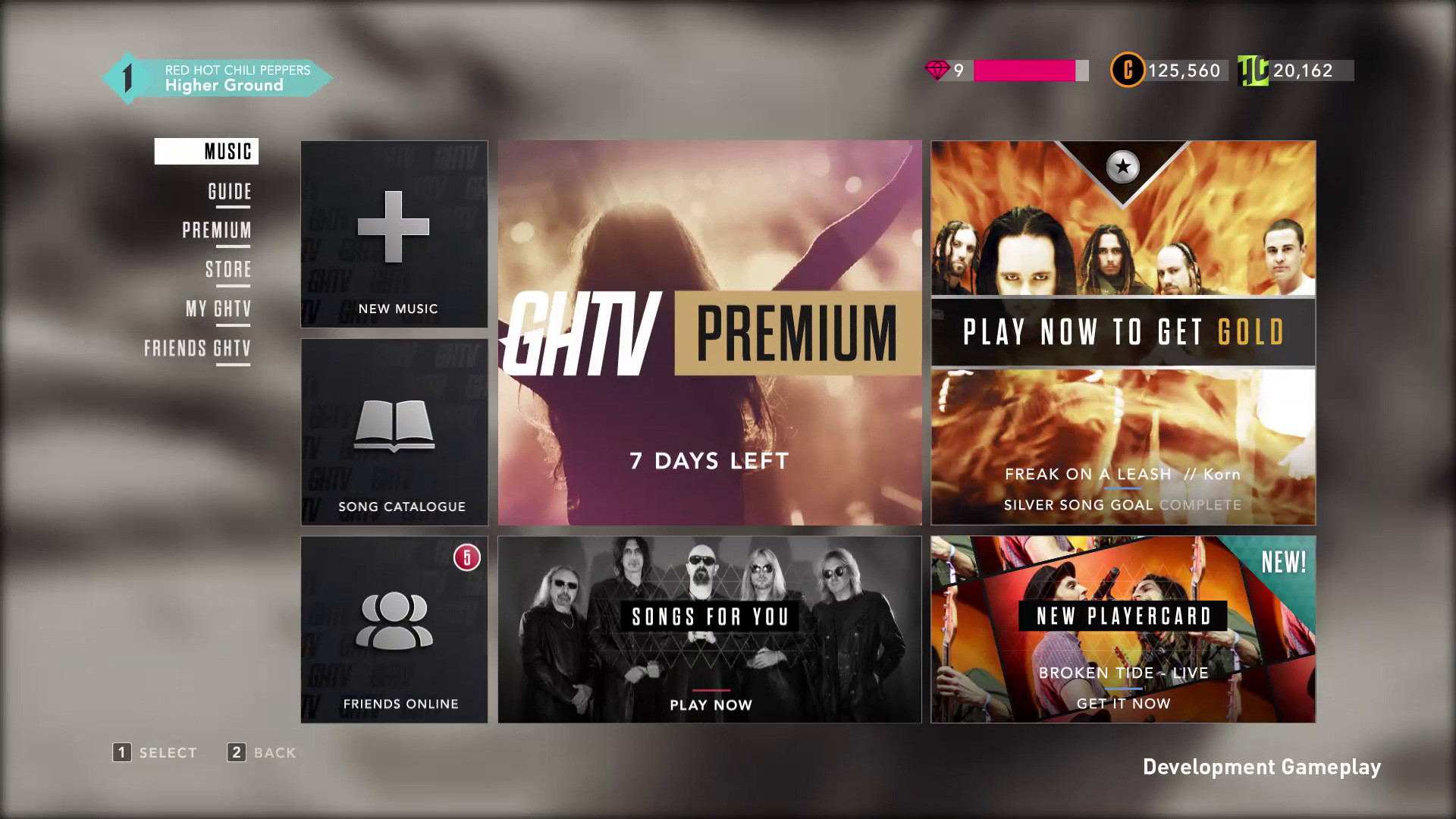 The GHTV mode in all its glory. This is Guitar Hero Live
The GHTV mode in all its glory. This is Guitar Hero Live
Guitar Hero Live’s GHTV mode, offering a vast library of streaming music videos.
While GHTV’s streaming nature means song selection is initially determined by curated channels, players can utilize “play tokens,” earned through gameplay or purchased with real currency, to access specific songs on demand. For players seeking extensive content without immediate additional spending, Guitar Hero Live and its GHTV mode offer a compelling value proposition.
Winner: Guitar Hero Live
Round 6: Downloadable Content and Song Ownership
For players willing to invest in downloadable content to expand their music libraries, the DLC ecosystems of Rock Band 4 and Guitar Hero Live present contrasting models.
Guitar Hero Live‘s GHTV library, while vast, operates on a streaming and token-based system. Players don’t permanently own individual songs within GHTV. On-demand song access requires tokens, which can be replenished through in-game currency or real-money purchases. Repeatedly playing favorite songs necessitates continuous token expenditure.
Furthermore, the full-motion video nature of the GH Live mode, with bespoke concert visuals for each song, makes adding new DLC songs to this mode prohibitively expensive. Consequently, the 42 on-disc songs in GH Live represent a fixed library, unlikely to expand with paid DLC.
Rock Band 4 adopts a traditional DLC model. Its engine is designed for seamless DLC integration, and a substantial portion of the Rock Band 3 DLC catalog has been ported to Rock Band 4, offering access to over 1500 songs for purchase.
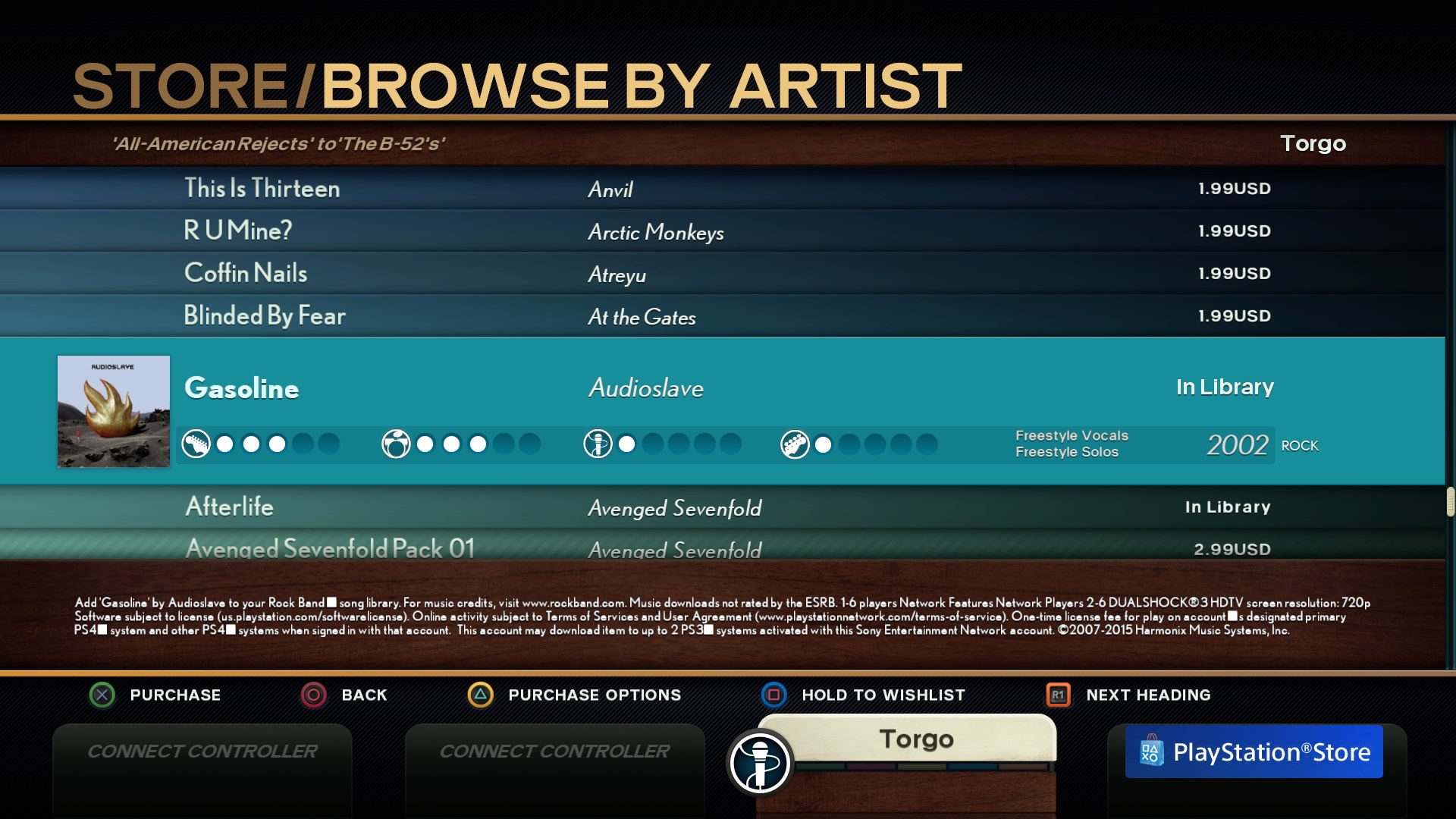 You can even buy Audioslave stuff if you want to pretend it
You can even buy Audioslave stuff if you want to pretend it
Rock Band 4’s extensive DLC library, offering a vast selection of songs to purchase and own.
Crucially, purchasing Rock Band 4 DLC grants permanent ownership of the songs, allowing unlimited play without recurring costs. For players committed to building a large and personally curated music library through DLC purchases, Rock Band 4 offers a more sustainable and ownership-focused model.
Winner: Rock Band 4
Round 7: Single-Player Experience and Progression
The single-player modes and sense of progression differ significantly between Guitar Hero Live and Rock Band 4, catering to different solo gaming preferences.
Guitar Hero Live, with its guitar-centric focus and first-person perspective, is clearly designed with single-player engagement in mind. The GHTV mode incorporates profile progression, rewarding players with experience points for song plays and performance. Leveling up unlocks customization options, such as note highway styles and profile icons, providing a sense of ongoing advancement.
GHTV songs also feature specific challenges, such as star targets and performance goals, adding replayability and encouraging mastery of individual tracks. Guitar Hero Live play offers a structured single-player experience with clear progression systems and unlockable rewards.
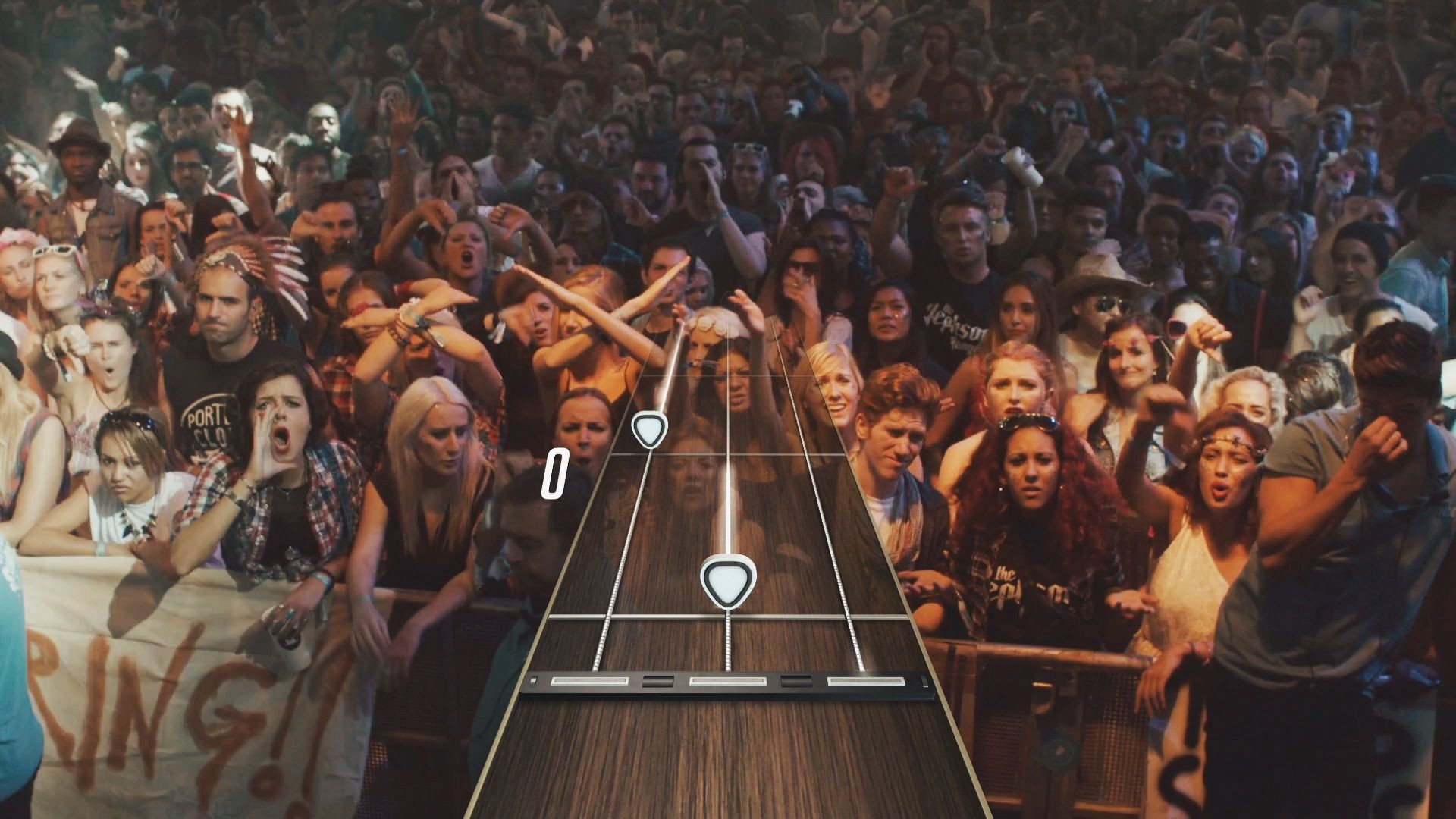 You
You
Guitar Hero Live’s GHTV mode incorporates progression and customization, enhancing the single-player experience.
Rock Band 4 provides a less extensive single-player experience. Its Career mode is relatively short compared to previous Rock Band iterations. Beyond the Career mode, single-player options primarily consist of Quick Play mode, offering direct song selection without a strong sense of overarching progression. For players seeking a deep and rewarding single-player journey with a clear sense of advancement, Guitar Hero Live provides a more compelling offering.
Winner: Guitar Hero Live
Round 8: Local Multiplayer and Social Gameplay
Local multiplayer is a cornerstone of the rhythm game genre, and Rock Band 4 and Guitar Hero Live offer contrasting approaches to shared gameplay.
Guitar Hero Live‘s local multiplayer capabilities are limited. It only supports a second guitar in GHTV mode, and even then, both players play lead guitar parts. This results in a competitive rather than cooperative multiplayer experience, as players vie for the highest score on the same instrument track. For social rhythm game sessions, Guitar Hero Live falls short compared to band-focused titles.
 Not even Weezer can make local multiplayer better in Guitar Hero Live
Not even Weezer can make local multiplayer better in Guitar Hero Live
Guitar Hero Live’s limited local multiplayer, focusing on competitive guitar play.
Rock Band 4, in contrast, is built for local multiplayer. It retains the classic band gameplay, allowing up to four players to perform together on guitar, bass, drums, and vocals. Rock Band 4 play in local multiplayer offers a cooperative and socially engaging experience, replicating the thrill of performing as a band with friends and family. While Rock Band 4 doesn’t revolutionize local multiplayer, it delivers a familiar and enjoyable band-based experience that remains a genre benchmark. For players prioritizing local multiplayer and social rhythm game sessions, Rock Band 4 is the clear frontrunner.
Winner: Rock Band 4
Round 9: Ongoing Updates and Long-Term Support
Both Harmonix and Activision have positioned Rock Band 4 and Guitar Hero Live as evolving platforms with ongoing updates and content additions.
Rock Band 4 has received updates introducing social score challenge features, character customization options, and the challenging Brutal Mode, enhancing gameplay depth and social engagement.
Guitar Hero Live has consistently expanded its GHTV library with new songs (over 90 added post-launch) and introduced customization options, such as themed note highways. It also added an online multiplayer mode, “Rivals,” where players compete against similarly skilled opponents for XP and in-game currency.
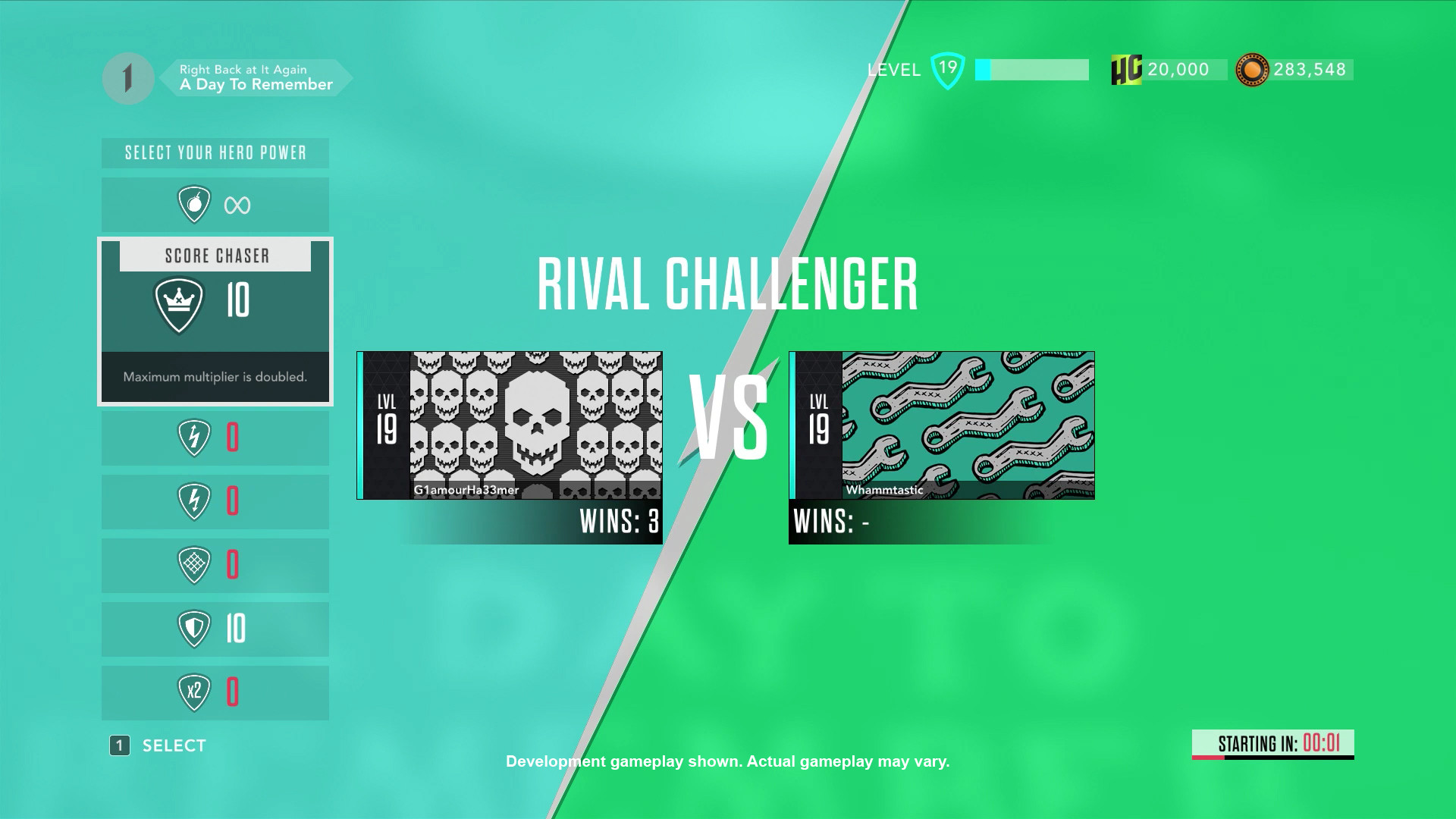 Guitar Hero Live Rivals mode
Guitar Hero Live Rivals mode
Guitar Hero Live’s Rivals mode, adding online competitive elements to GHTV.
Both games demonstrate a commitment to ongoing support, promising continued content updates, customization options, and potential gameplay feature expansions. This commitment suggests that both Rock Band 4 and Guitar Hero Live are poised to evolve and improve over time, regardless of initial purchase choice.
Winner: Draw
The Verdict: Choosing Your Rhythm Game Hero
Ultimately, the choice between Guitar Hero Live and Rock Band 4 hinges on individual playstyle preferences and priorities.
If you are primarily a single-player gamer seeking a focused guitar experience with a sense of progression and a constantly expanding library of streaming music, Guitar Hero Live is an excellent choice.
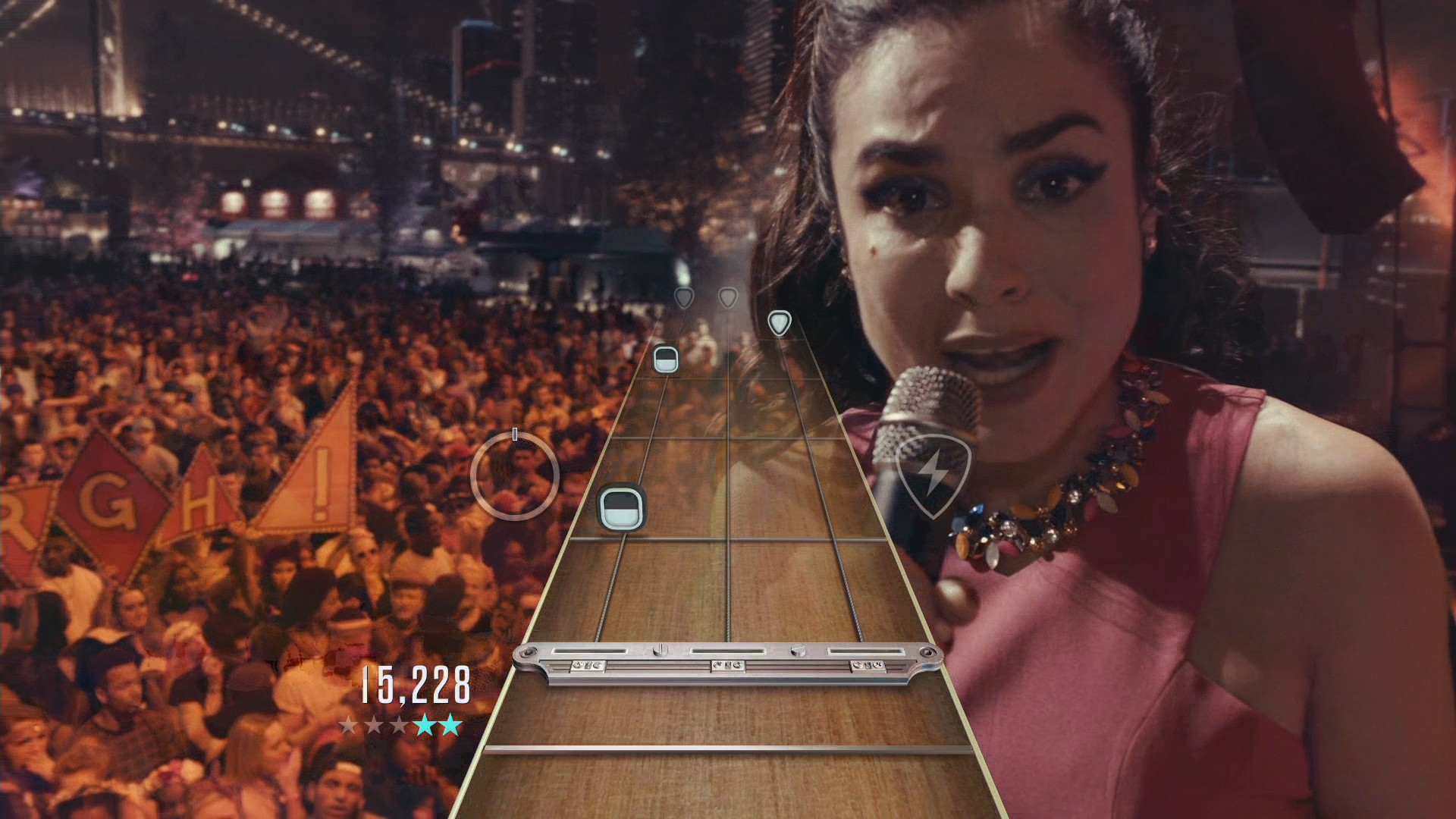 Yes, even despite these beautiful arseholes
Yes, even despite these beautiful arseholes
Guitar Hero Live, a strong choice for single-player guitar enthusiasts.
Despite the potentially divisive live-action visuals of GH Live mode, the GHTV mode’s vast library and progression system offer long-term single-player engagement. The innovative six-button guitar controller also provides a fresh and challenging gameplay experience for rhythm game veterans seeking a new control scheme.
Conversely, if you value local multiplayer, band-based gameplay, and building a permanent, owned library of downloadable songs, Rock Band 4 is the superior option.
 Rock Band 4 pic 2
Rock Band 4 pic 2
Rock Band 4, ideal for social gamers and band-based multiplayer experiences.
While its single-player mode may lack depth compared to Guitar Hero Live, Rock Band 4‘s unparalleled local multiplayer and extensive DLC ecosystem make it the definitive choice for social rhythm game experiences and building a vast personal music library.
Price considerations also factor into the decision. Guitar Hero Live often retails at a lower price point, especially for the guitar bundle, while Rock Band 4 bundles, particularly full band bundles, tend to be more expensive. However, Rock Band 4‘s backwards compatibility with older instruments can mitigate costs for players already invested in the Rock Band ecosystem.
Finally, platform availability may dictate the choice for some players. Guitar Hero Live was released on a wider range of consoles, including older generation systems like Wii U, Xbox 360, and PS3, while Rock Band 4 focused on current-generation consoles.
In conclusion, both Guitar Hero Live and Rock Band 4 offer compelling rhythm game experiences, catering to distinct player preferences. Guitar Hero Live excels in single-player guitar gameplay and content variety through GHTV, while Rock Band 4 reigns supreme in local multiplayer and DLC ownership. Ultimately, the best choice depends on how you intend to guitar hero live play and what aspects of the rhythm game genre you value most.

